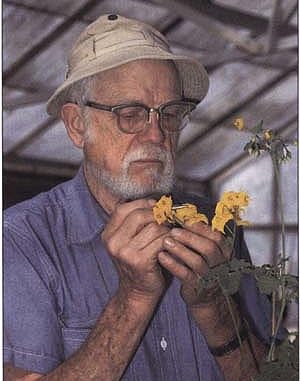
Libby James
Charley Rick was puzzled. He had just returned from a trip to the Galapagos Islands off the coast of Ecuador, bringing home bags of wild tomato seeds. A professor at the University of California at Davis, in the department of vegetable crops, his plan was to germinate and grow the seeds for research purposes.
But the seeds Rick planted did not grow. “Hmmm. What’s the problem here?” He wondered. “What do the Galapagos Islands have that we do not?”
Before the words were out of his mouth, the answer came to him. ‘Tortoises!” he exclaimed.
Rick went searching for a tortoise close to home, and when he found one, he brought it back to his laboratory and fed it wild tomato seeds.
Sure enough, the seeds grew when they had first been passed through the digestive system of a tortoise. He wanted to grow these seeds in order to learn about and preserve the hardy traits he observed in the wild tomatoes. He hoped to crossbreed them with domestic tomatoes that grow in gardens and that are available at the grocery store and farmers’ markets.
Over time, Rick experimented with tomatoes until he was able to produce varieties that are sweeter, get fewer diseases, and attract fewer insects.
Long ago, tomatoes were thought to be poisonous. They were described as having a “strong, stinking smell,” and being unhealthful to eat. Today we eat them all the time, in tomato sauce used for pizza, as the primary ingredient in catsup, and in salads and sandwiches.
The first known tomatoes grew high in the Andes Mountains in South America. Travelers carried them to Mexico, and in the 1500’s European explorers discovered them n Mexico and took them home. Italians became especially fond of them. They called them “love apples” and ate them with olive oil, salt, and pepper.
The journey of the tomato continued as Europeans came to settle in North America. Some of these travelers took tomato plants back to Europe with them.
Charley Rick studied tomatoes for more than 40 years, traveling twice to Peru and three times to the Galapagos Islands. His collection of seeds grew until he had 900 varieties of tomato seeds.
These seeds have been carefully stored and Charley Rick willingly shared them with scientists from all over the world in order to encourage research.
Rick had so many adventures while collecting tomato seeds that his friends began calling him Indiana Jones. He was in a car accident on a terrible road in the Andes. Luckily, he was not hurt.
Once, he and his wife paddled a leaky dugout canoe over several miles of open water to reach the Galapagos. Another time, he reached the islands in an old freighter that had been lengthened three times and took on water at the seams.
At first, people in the Galapagos laughed at Rick for hunting what they thought were weed seeds. But when he explained what he was doing, the island people began to help him, often bringing him bags of tomatoes, other times leading him to spots where they knew tomatoes grew. The children were the most helpful,” he said.
Rick was a storyteller and he loved to recall the tale of how he discovered what it took for tomato seeds to germinate and grow.
He was born in 1915 in Reading, Pennsylvania, and earned degrees at Penn State and Harvard universities. He died in Davis in 2002 at age 97 after a long and productive life. The work he did in his laboratory greatly improved the taste and hardiness of tomatoes. Rick is also known for improving many common fruits and vegetables.
It is interesting to note that another Charley, Dr. Charles Arson, of the Biodesign Institute at Arizona State University in Tempe, Arizona has worked on developing a vaccine made from tomatoes that will prevent diarrhea. He hopes it will be a big help in reducing the deaths of babies and small children in places like Africa and India. The World Health Organization has taken an interest in his work and recognizes the health benefits of tomatoes.
Support Northern Colorado Journalism
Show your support for North Forty News by helping us produce more content. It's a kind and simple gesture that will help us continue to bring more content to you.
BONUS - Donors get a link in their receipt to sign up for our once-per-week instant text messaging alert. Get your e-copy of North Forty News the moment it is released!
Click to Donate
